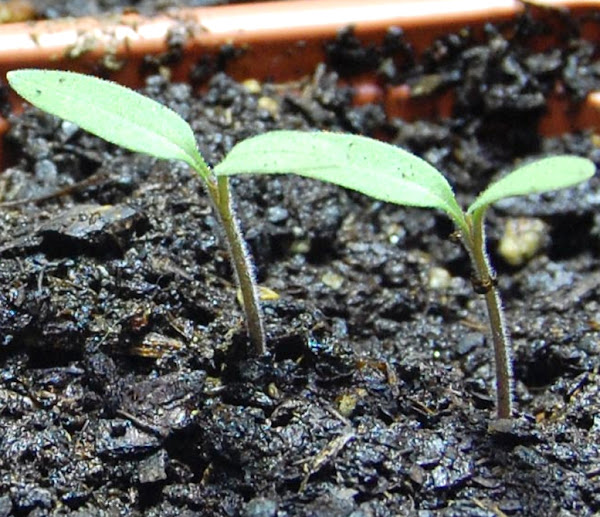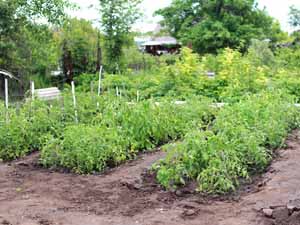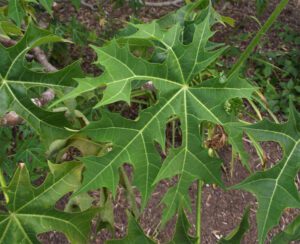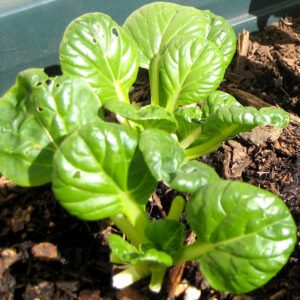Growing tomatoes in the home garden is very easy and it’s probably the most rewarding experience. In this guide we are not describing about commercial methods of growing tomatoes.
Rather we are going to discuss about the ways of growing organic tomatoes in your home garden, just for family use. You can also share tomatoes with your friends or relatives, if you get a bumper production.
Organic homegrown tomatoes are actually more tasty, flavorful and nutritious than the commercially grown tomatoes that we buy from shop.
Today farmers are growing tomatoes commercially in soil-less environment by using mostly chemical fertilizer solution, and most of those tomatoes are picked before they are ripe completely.
These practices in soil-less commercial production system result in tomatoes with excellent looks. But these tomatoes don’t taste as good as homegrown tomatoes.
These tomatoes are also not as nutritious, flavorful and healthy as the tomatoes grown organically in the home garden.
All these are probably the reasons of increasing the demand of growing tomatoes organically in the home garden. Today, most of the health conscious people are trying to grow their own food organically in their home garden.
How to Start Growing Tomatoes
Growing tasty, flavorful and healthy tomatoes is very easy and simple if you follow the right steps for growing tomatoes in the home garden.

Here we are describing more about the steps of growing tomatoes organically in the home garden.
Choose a Variety
First of all, you have to choose the right variety of tomatoes. There are actually many different varieties available to choose from.
Some varieties are of large size, some are small, some are of amazing color, some varieties are made for specific regions, some varieties are of bush type and some varieties are dwarf. Some varieties take less time to harvest (less than 2 months) and some require around or more than 3 months.
You have to choose the right variety depending on your choice, location and purpose. You can consult with an existing farmer in your area for better recommendation (any of your relatives or friends who is growing tomatoes).
Collect/Purchase Seeds
After selecting the varieties, collect seeds from your friends, relatives or any existing farmers. You can also purchase seeds from any seed supply stores in your area.
Currently some popular seed companies are selling seeds through their online stores.
Time for Growing Tomatoes
Tomatoes actually can be grown throughout the year. And there are some tomato varieties available that grow and produce fruits throughout the year.
You can actually start growing tomatoes after the frost disappears. You can plant seeds indoor prior to 6-8 weeks of the average last spring frost date, if you want to have an early harvest.
Tomatoes can be grown any time where there is no fear of frost, especially in the southern tropical areas. Although you can’t expect good yield in excessive hot temperatures. Around 22 degrees Celsius temperature of the soil is ideal for germinating the tomato seeds.
Prepare the Soil
Tomatoes grow in almost all types of soil, except heavy clay. Actually loam and sandy loam soils are considered best for growing tomatoes.
You can expect a very good yield if the soil get full sun, well drained and is rich with organic materials. You can dig soil to about 1 ft deep and mix compost or manure 2-4 weeks before planting seeds or small plants.
If the soil in your garden has lots of clay, then you can make it ready for growing tomatoes by tilling the soil and incorporating sand, sawdust and other organic amendments before planting.
Never use chemical fertilizer, and try to use as much organic materials as you can (manure, compost, tree leaves etc.). Adding compost, manure or other organic materials also help to improve clay soil.
Planting
You can plant either seeds or seedlings when the soil is warm (after last spring frost, if you live in northern areas). It’s good to start in pots or containers and then transplant.
The seedlings will be ready for transplanting when they are of approximately 6 inches height.
If you plant seeds indoor, then hardening off transplants is very important (because there are differences in temperatures). Before planting in the garden, harden off transplants for a week.

For hardening off transplants, set transplants outdoors in the shade for a couple of hours for the first day. And then gradually increase the amount of time your plants are kept outside each day (include some direct sunlight).
During the time of planting, it will be better if you can place tomato stakes or cages in the soil. Although growing tomatoes without cages or stakes is also possible and it’s not a mandatory.
Stakes or cages keeps the fruits clean and fresh. Staking actually keeps the developing tomatoes off the ground and the caging helps the plant to hold itself upright.
The ideal planting distance between two plants is 2 ft. When planting seedlings, you can pinch off a few of the lower branches. Plant the root ball deep enough so that the remaining lowest leaves are just above the surface of the soil.
It’s very important to water well after planting the seedlings. Because watering helps to reduce shock to the roots.
Caring for the Tomato Plant
Don’t follow ‘plant and forget’ rule for growing tomatoes. Tomato plants require additional caring for good yield. Follow the steps mentioned below for caring tomato plants.
Feeding
Feeding means ‘adding amendments in the soil after a certain period of time for keeping the plants growing and producing more flowers and fruits’.
You can use liquid comfrey or seaweed tonic formulated for tomatoes for feeding the plants. Remember, you need to feed the plants on a regular basis, for example weekly.
Tomato plants have two types of root. One is deep roots and another type is shallow roots. Deep roots work for transporting water for the plant from the soil. While the shallow roots absorb nutrients. So, it will be better if you drench the soil around the plant while feeding.
Watering
Water the plants generously for the first few days after transplanting. You also need to water the plants well throughout the growing season.
Watering deeply in the growing season is very important for strong root development. Early morning is the best time for watering tomato plants.
Mulching
Mulching is important for retaining moisture in the soil and also for preventing weeds. You can mulch 5 weeks after transplanting.
Pruning
Prune the plants by pinching off side stems (suckers), if you are using stakes and keep only a couple of branches.
Weeds Control
Weeds controlling in tomatoes is always important, because weeds take nutrients from the soil and some common weeds are hosts of pets and diseases.

You can easily control the weeds from your garden if you spent some time daily in the garden.
Controlling Pets & Diseases
Like many other plants, tomatoes are susceptible to insect pests and some diseases. And it’s a common problem for growing tomatoes. So you must have to take necessary steps for controlling pests and diseases.
The most common pest that affect your tomatoes is whitefly. The adult whiteflies lay eggs on the underside of the leaves. Try spraying with water to wash them off. Do this immediately when you see the eggs. You can also remove the eggs by hand.
The tomato blight is caused by the fungus Phytophthora infestans. Brown marks on the leaves are the common signs of this which increases in size quickly. Any developing fruit will start to turn brown and rots if left. Spraying baking soda will help to prevent this.
Aphids are also common in tomato plants. Spraying the plants with water will help to prevent this. And planting Marigolds attract beneficial insects and these will love eat aphids (blackfly).
Mosaic virus is also common in tomato plants. There are actually many different types of mosaic virus which can affect tomato plants. This is a very infectious virus and can be transmitted from plant to plant by humans.
Planting resistant tomato varieties will help to control this virus. Don’t save seeds from the infected plants. You can use least-toxic, natural pest control products for preventing this disease such as neem oil, soap, diatomaceous earth etc. Also destroy all the infected plants from your garden.
Cracking is also a common problem for growing tomatoes. Actually the skin of the fruits will crack, especially when fruit growth is too rapid. Cracking generally occurs due to uneven watering and uneven moisture from weather conditions. Consistent mulching and watering, and keeping the moisture levels constant will help to prevent cracking.
Harvesting Tomatoes
This is the most enjoyable and pleasuring part of growing tomatoes in the home garden. You should pick as soon as the tomatoes are ripe.
You can easily identify the ripe tomatoes by their color and size. Immediately picking the ripe tomatoes will encourage the plants to produce more fruits.
Harvest seeds from some best tomatoes for next season. Good luck!






